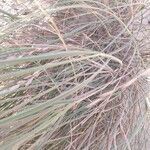Tough stoloniferous perennial, the stolons rooting to form dense tussocks; culms up to 100 cm tall or more, rigid, woody, branching to form fascicles at the nodes; leaf laminas up to 45 cm × 4 mm, narrowly linear to setaceous, flat or involute, stiff, glaucous.
Spikelets 12–26 mm long, 8–25-flowered, lanceolate to ovate or oblong; glumes 6–9 mm long, narrowly ovate, coriaceous, acute; lemmas 7–9 mm long, lanceolate to oblong-lanceolate, asperulous or minutely hairy.
Inflorescence 10–40 cm long, linear to narrowly lanceolate.

